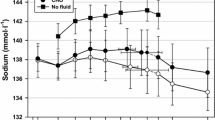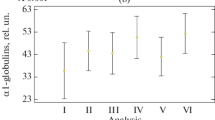Abstract
The objective of this investigation was to determine the effect of a daily intake of fluid and salt supplementation (FSS) in preventing the development of changes in blood plasma concentrations of microelements that occur during prolonged restriction of muscular activity (hypokinesia). The studies were performed on 30 endurance trained male volunteers aged 23–26 yr with an average maximum oxygen uptake 64 mL/kg/min during 364 d of hypokinesia (HK). They were divided into three equal groups: Ten volunteers were placed continuously under an average of 10,000 running steps/d (control subjects), ten volunteers were subjected continuously to HK without the use of FSS (hypokinetic subjects), and ten volunteers were submitted continuously to HK and consumed daily FSS in very small divided doses (hyperhydrated subjects). For the simulation of the hypokinetic effect, the hypokinetic and hyperhydrated endurance trained male volunteers were kept continuously under an average of 3000 walking steps/d for 364 d. Prior to their exposure to HK, all volunteers were on an average of 10,000 running steps/p d. During the prehypokinetic period of 60 d and during the hypokinetic period of 364 d were determined the concentrations of calcium, magnesium, manganese, lead, iron, copper, tin, nickel, zinc, and cobalamine in blood plasma of endurance trained volunteers. During the hypokinetic period blood plasma concentrations of microelements decreased in hyperhydrated volunteers, whereas in hypokinetic volunteers increased significantly. The differences between the hyperhydrated and hypokinetic volunteers were significant with respect to their concentrations of microelements in blood plasma. It was concluded that chronic hyperhydration may be used to normalized blood plasma concentrations of microelements in endurance trained volunteers during prolonged restriction of muscular activity.
Similar content being viewed by others
References
Yu. M. Bala and V. M. Lifshits,Trace Elements in the Practice of Internal Medicine, Meditsina, Voronezh, 1973, p. 240.
L. P. Bushmeleva,Biological Role of Trace Elements and Electrolytes, and Their Significance in Medicine, Meditsina, Tomsk, 1977, p. 255.
Y. G. Zorbas, Y. F. Federenko, and K. A. Naexu,Bone mineralization and plasma concentrations of electrolytes in healthy subjects after exposure to hypokinesia and hyperhydration. Wiener Klinische Wochenschrift, 105/1; 26–35 (1993).
Y. G. Zorbas, Y. F. Federenko, and K. A. Naexu, Plasma Trace elements concentrations in trained subjects after exposure to hypokinesia and daily hyperhydration.Biol. Trace Elem. Res. in press.
J. Durnin and M. Rahaman, The assessment of the amount of fat in the human body from measurements of skinfold thickness.Br. J. Nutr. 21, 681–689 (1967).
Y. G. Zorbas, Y. F. Federenko, and K. N. Naexu, Effect of daily hyperhydration on fluid electrolyte balance and renal excretion thereof in trained subjects during prolonged hypokinesia.Model. Simul. Control. 41, 37–60 (1993).
Author information
Authors and Affiliations
Rights and permissions
About this article
Cite this article
Zorbas, Y.G., Federenko, Y.F. & Naexu, K.A. Blood plasma concentrations of microelements in endurance trained volunteers during hypokinesia and chronic hyperhydration. Biol Trace Elem Res 41, 253–267 (1994). https://doi.org/10.1007/BF02917427
Received:
Accepted:
Issue Date:
DOI: https://doi.org/10.1007/BF02917427




